Deconstruyendo héroes de Fire Emblem
Nintendo es la única luz brillante en la industria de los juegos móviles. Finalmente entrando en escena después de años de resistirse a la tendencia, desde el verano pasado Nintendo lanzó 3 títulos de gran recaudación: Pokemon Go, Super Mario Run y ahora Fire Emblem Heroes. Nintendo está haciendo lo que ningún otro desarrollador de juegos gratuitos ha hecho. Han irrumpido en un mercado que muchos habían asumido durante mucho tiempo que estaba completamente cerrado.
Pero cada lanzamiento ha estado marcado por la controversia. Pokémon GO no fue desarrollado por Nintendo y Nintendo sólo obtiene una fracción de las ganancias. Super Mario Run recibió críticas mediocres y muchos veteranos del juego gratuito se preguntaron si el modelo "Free-to-Start" era el sistema eficaz para generar la mayor cantidad de ingresos y disfrute del producto. A pesar de esta controversia, Pokémon Go generó ingresos de casi mil millones de dólares en 2016 . Super Mario Run ha generado 53 millones de dólares y convierte el 5% de su base de jugadores. Independientemente de su opinión sobre su enfoque, estos son números muy impresionantes.
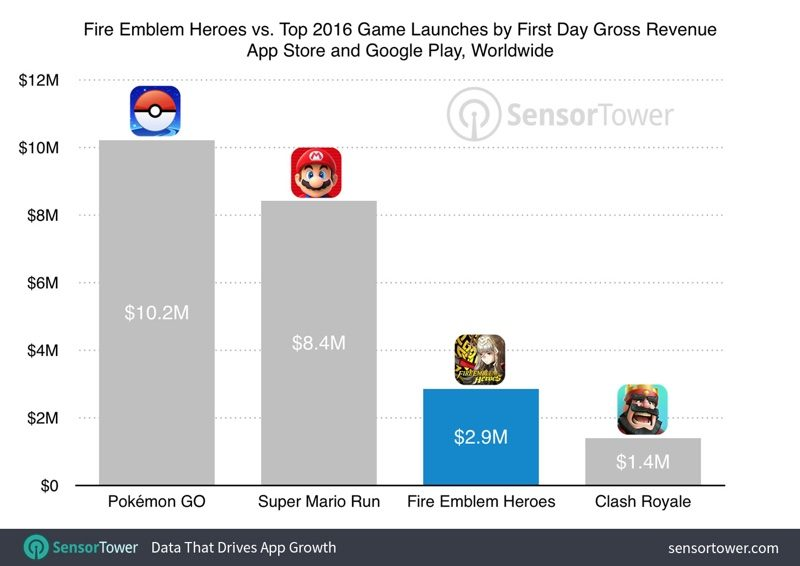
Fire Emblem Heroes es el primer juego de la serie que se acerca más a cómo se han creado tradicionalmente los juegos gratuitos para dispositivos móviles. Es obvio que este juego fue construido en estrecha colaboración con DeNA. Este juego comparte muchas cosas con otros productos de DeNA y muchos otros juegos de rol móviles F2P japoneses.
Hasta ahora las críticas son positivas para el juego, tanto de críticos como de jugadores y analistas de negocios. El juego ya ha recaudado más de 5 millones de dólares , una semana después de su lanzamiento y ha alcanzado casi el Top 10 en recaudación en los EE. UU., y es el juego número 2 en recaudación en Japón. Sin duda será otro gran éxito para Nintendo.
Revelación completa: soy un gran fanático de Nintendo. Al igual que la mayoría de los desarrolladores de juegos de la industria, crecí jugando a Nintendo. He tenido todas las consolas de Nintendo desde la NES y he reservado la Switch solo para jugar a Zelda el día del lanzamiento. Estoy animando a Nintendo con cada lanzamiento que hacen en dispositivos móviles. Sinceramente espero que Nintendo continúe operando como la estrella brillante en la industria como una compañía que continúa ofreciendo juegos increíblemente divertidos y accesibles durante las próximas décadas.
Dicho esto, he jugado a Fire Emblem Heroes desde su lanzamiento y, a pesar de todos los elogios que ha recibido desde su lanzamiento, Nintendo deberá realizar mejoras notables para garantizar que el juego dure a largo plazo.
Primero echemos un vistazo a lo que hicieron bien: cómo está diseñado el núcleo del juego.
The Core Loop: probado y verdadero
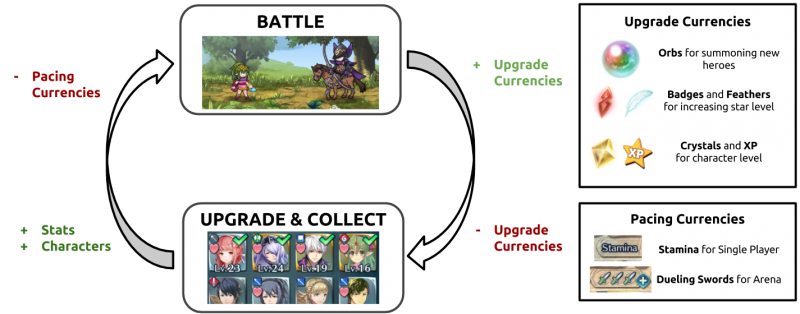
El Core Loop de Fire Emblem Heroes está probado. Los jugadores luchan para obtener recompensas , mejorar y recolectar más héroes. Sus héroes mejorados les permiten acceder a batallas más desafiantes que brindan cada vez mejores recompensas.
Para que este juego se retenga y monetice al máximo, el jugador siempre debe tener el deseo de recolectar constantemente nuevos héroes y actualizar tantos como sea posible a su nivel máximo.
la gacha
Para recolectar estos héroes, debes usar el sistema de caída aleatoria basado en gacha. Los jugadores recolectan orbes a través de campañas para un jugador para eventualmente iniciar una invocación. Estas convocatorias se sienten geniales. Obtener un personaje famoso es recompensado con una animación única que realmente cautiva la sensación de obtener algo único y especial (como se ve a continuación). Nintendo creó una gran sensación de flujo gacha.
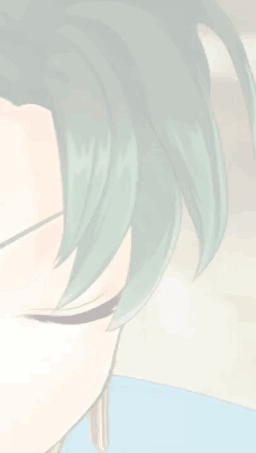
Las invocaciones cuestan inicialmente 5 orbes. Al invocar, al jugador se le presentan 5 opciones, codificadas por colores. Como puede ver en la imagen a continuación, el reproductor tiene 1 opción roja, 1 azul y 3 grises. Este código de colores está coordinado con los tipos de unidades que usa el jugador en la batalla principal.
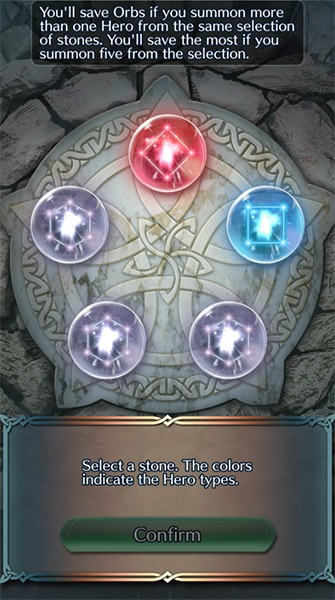
Entonces el jugador puede ser estratégico al elegir el color que quiere. Si quieren un jugador que sea del tipo rojo, pueden centrar sus invocaciones en gachas rojas. Al invocar, al jugador se le presenta un personaje, que va de 1 a 5 estrellas, dependiendo de la suerte que tenga.
Pero Nintendo también ofrece otro aspecto de la invocación. La invocación se vuelve menos costosa cuanto más convocas del mismo grupo. Vea la imagen de arriba. Después de recibir 5 piedras de colores, la primera selección cuesta 5 orbes, la segunda cuesta 4, la tercera cuesta 4, etc. Entonces, para ahorrar orbes sustanciales, los jugadores optan por pulir para obtener más. Para guardar 5 orbes por cada 5 personajes que invocas, necesitas 20 orbes inicialmente. Una decisión de diseño interesante que brinda a los jugadores una forma adicional de optimizar su rutina.
Cada día, los jugadores buscan incesantemente recolectar orbes para poder invocar a sus personajes favoritos de la serie. El jugador puede recolectar orbes del juego normal. Cada vez que completan una misión para un jugador, son recompensados con un solo orbe. Dado que la dificultad de las misiones para un jugador aumenta rápidamente, la velocidad a la que los jugadores pueden recolectar orbes disminuye rápidamente. El juego pasa de un progreso rápido a tener que entrenar a tus héroes con frecuencia para obtener orbes.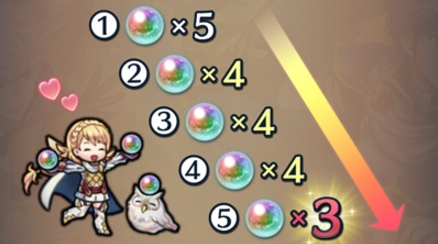
Este es un método probado y verdadero de diseño de monetización gratuito. Reduce el ritmo de la colección gratuita de personajes a un ritmo que los jugadores empiecen a querer gastar para acelerar su progreso nuevamente.
La batalla: simple, estratégica y basada en estadísticas
Lo que creo que impulsó los elogios de este juego fue el sistema de batalla central. Nintendo logró tomar un género que muchos han probado y hacerlo más amigable para dispositivos móviles que cualquier otro juego de estrategia por turnos que haya jugado en dispositivos móviles.
The game’s orientation is in portrait, and the key interaction is just dragging and dropping your unit around the field. It feels immediately intuitive, easy to play while on the go, and I rarely make a misstep with my commands.
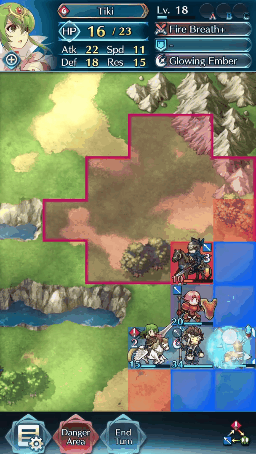 On top of a core interaction that is accessible, they managed to make the entire experience of completing a battle fit into the Starbucks test . You can complete a regular battle in roughly 40 seconds, a more strategically demanding battle in easily less than 3 minutes.
On top of a core interaction that is accessible, they managed to make the entire experience of completing a battle fit into the Starbucks test . You can complete a regular battle in roughly 40 seconds, a more strategically demanding battle in easily less than 3 minutes.
The battles are usually 4 units vs 4 opposing units, really cutting down on the amount of moves you need to make per battle. Because each map is fairly small, it usually doesn’t take very long for the main action to start. Ultimately these short, punchy battles make for a great “just one more battle!” feeling.
The Strategy
All this being said : simple interaction, small maps, small armies — this game has strategic depth. Based on the fire emblem battle systems that were designed back in 1990, Intelligent Systems (the game developer who makes the Fire Emblem series) has perfected this system over the years. Fire Emblem have been always known for their simplicity depth. Working very well on mobile through the Gameboy Advance, DS, and 3DS years with stylus touch controls.
The battle system starts with an easy to understand rock – paper – scissors-like system. With fire emblem, its red beating green, green beating blue, blue beating red.
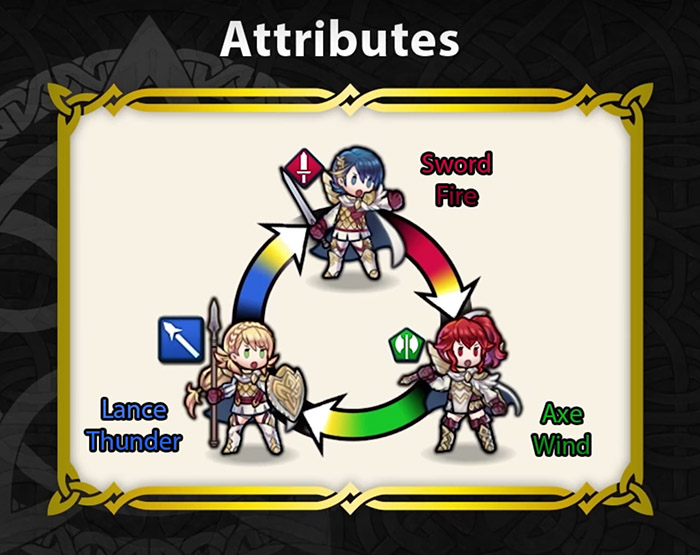
This is easy to understand, and the game gives enough in-game cues when you’re taking advantage of this system. You can expect a 20% boost to your damage when attacking a weaker element, or a 20% reduction when fighting against a stronger element.
From here, the player can start to notice other strategic advantages they can take in battle. Archer mage units can fire from a distance. Horseback and flying units can move quickly across terrain. Walls mountains can make being a range unit more advantageous. Units can gain abilities that buff and de-buff other characters. There is a lot of strategic depth here which keeps each battle feeling fresh and collecting heroes relevant.
The Stats
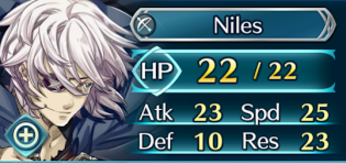
The stats and their impact are all also very easy to understand. Atk is attack damage, which is counter to HP (Hit Points). Spd is speed, which if you have 5 more speed than an opponent, you hit twice. Def is defense, which is subtracted from the opponent’s attack when you are defending. Res is magical resistance, which is similarly subtracted when you are attacked by a magical spell.
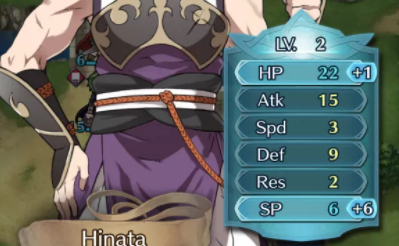
Each time a character gains a level they are rewarded with a random selection of increased stats. This allows the actual numbers themselves to stay relatively small and understandable, and means that having two of the same character could mean different stats. Great for collectors and min/maxers.
But if these stats were pure random, you could see how builds could become unpredictable. Because the battle math is so basic (it just uses addition and subtraction), calculations could easily get out of control without Nintendo “guiding” the progress of characters to ensure that the values stay within limits. As such, it is obvious that nintendo has pre-planned the progression of each character from the beginning. While each character can have different stats, they try to stay within a controlled range and by the maximum level each character has the same amount of stat points. So no matter your luck, each character will be equal in theory, but mix/max style players can try to find duplicates of characters to find the optimal build.
But what’s important with the stats is that it supports the core loop. As stated before, the core loop only works if players constantly have pressure to upgrade their characters. This system really puts pressure on the players to level up their units. Being just a few levels under another unit could mean your Defense stat being low and taking a lot of damage. It could mean your Attack stat is just a few points lower than an opponent’s defense stat and thus can’t do any damage.
This system doesn’t leave players with much space to compete at higher levels with their strategic skill alone. They need to level up every character in their team.
Smartly by Nintendo, there is a lot of strategy in choosing who to bring into each battle. You are always given a preview of the opponent’s stat level, the makeup of their team, so you can effectively plan outside the battle who you want to bring.
This level, “Prince of Mystery” has 2 red swordsmen, an archer, and a green mage all at around level 24. I can craft my team around taking advantage of this team’s weaknesses. I can ensure that my team is around level 24 before starting the battle. This feels both strategic puts more pressure on the core loop: collecting upgrading a large variety of heroes.
3 Improvements for Nintendo
Overall while the core game and overall progression feel great, after playing for weeks its obvious that Nintendo still needs to fill in some of the cracks to make sure this game can last on the top grossing charts. From playing I noticed 3 issues that Nintendo should consider for their future:
#1 Gacha Drop Tiers Rates
Nintendo did a lot right with Fire Emblem Heroes’ gacha system. They have over 60 characters in the pool to pull from, adding more every few weeks and each feeling unique and strategic. They paced their orbs so that in the beginning you feel like you’re making quick progress, but as time goes by the pacing slows down substantially.
They’ve also built a system which having a 5 star character means a lot: to upgrade a character from a lower star rating to a higher star rating takes considerable time and effort. So players are more likely to convert chasing after the 5 star character in the gacha than attempt to upgrade them from a lower star level.
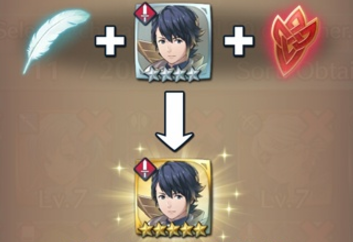 But this is where the simplicity of their hero progression system starts to show some issues. To upgrade a 4 star character to 5 star takes 20,000 feathers and 20 badges. To get this type of currency takes weeks of grinding. You can get feathers from competing in the PvP Arena once per week or sending your characters home. But playing for a few weeks I have gained ~4,000 feathers, mostly from sending home 4 star players I didn’t want. To get to 20,000 is a long painful grind.
But this is where the simplicity of their hero progression system starts to show some issues. To upgrade a 4 star character to 5 star takes 20,000 feathers and 20 badges. To get this type of currency takes weeks of grinding. You can get feathers from competing in the PvP Arena once per week or sending your characters home. But playing for a few weeks I have gained ~4,000 feathers, mostly from sending home 4 star players I didn’t want. To get to 20,000 is a long painful grind.
Players see clearly that to manually increase a single character’s star level is insanely difficult. This system has already seen some backlash from players, enough that Nintendo gifted out 10,000 feathers as part of a social media campaign. So the only effective way to get 5 star heroes means pulling them from the gacha pool — that must be great for monetization right?
That starts to break down when you hear experiences like this:
“…After my first day of play I had assembled a formidable team of five-star heroes, with 12 heroes of varying abilities in reserve…”
– Pocket Gamer Reviews
For myself as well, I have three 5 star heroes on my team, after spending $13 USD and a few days playing the game. I got the three 5 star heroes off of summons I didn’t pay for. I had so many free summons from regular play that it was easy to collect a wide variety of heroes. From these summons, I’ve already got three 5 star characters which helps me steamroll over the single player campaign of this game.
This could just be luck, but it seems to be happening to many players of the game. So I did some calculations:
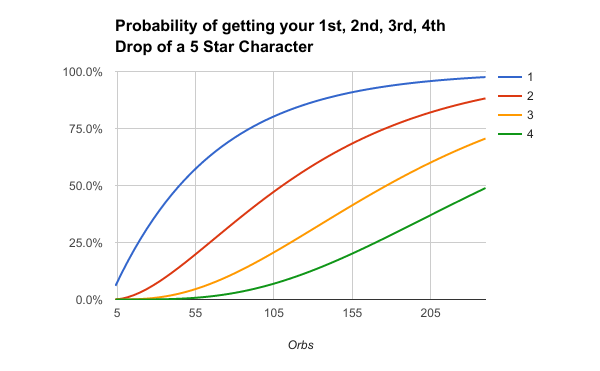
The drop rate of a 5 star hero is 6%. So every time you spend 20 orbs, you have a 26.6% chance of getting at least one 5 star hero in the pack of 5. After spending 40 orbs, there is a 50% chance you will have at least one 5 star character. Not to mention Nintendo even increases the % chance of getting a 5 star character each time you fail to get one in a summon. Nintendo is specifically designing the gacha around players getting 5 star characters fast.
Getting multiple 5 star characters on your team would be fine if Fire Emblem Heroes had enough pressure built into the core loop around collecting a large variety of heroes, but since the game is so early, this isn’t the case. After you’ve collected four 5 star heroes, you can rip through content and walk away happy from the game. Only the die hard fans — the ones who are here just to collect for the sake of collecting — will engage in the gacha.
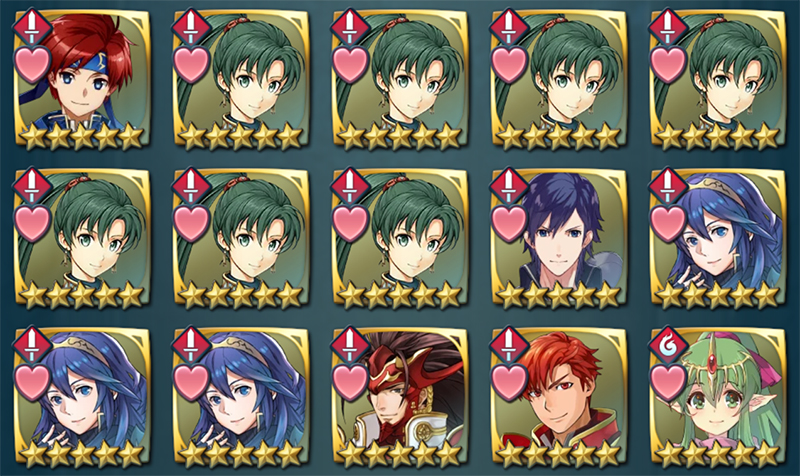
5 Gold Stars don’t matter if they happen all the time.
In the effort by Nintendo to make a player friendly feeling gacha, they’ve built a system where 5 star characters are so common that I can reach a optimal team within a week of play.
Compare this to the competition
- In Clash Royale, it takes months to raise to the arenas necessary to get access to the legendary cards, and from there they drop at such a low percent that it takes months to get the legendary cards levelled up fully
- In Contest of Championsit takes weeks to collect enough shards for a single 5 star hero crystal that you can redeem in game. 5 star heroes rarely ever drop in crystals collected from regular play.
So for Nintendo, for Fire Emblem to last they have to take a page from Puzzles and Dragons, Brave Frontier and other JRPGs. Introduce more star tiers with increasingly difficult gacha odds. Adjust the balancing for feathers and star progress so that it is feasible to reach a higher tier. From this, a player’s pursuit of the optimal team will take more than a week of play and a small amount of money.
#2 More Interesting Upgrade Path
Layering on top of the issue from the gacha, comes to the Upgrade system. After you’ve gotten the top 5 star character, the effort it takes to build it to its optimal level is too simple and short.
To reach the optimal build of a character:
- The character must be 5 stars
- Reach Level 40 by collecting XP or using shards
- Merging a Duplicate 5 Star for an Enhancement
Each unit has a level cap of 40, which can be reached by collecting enough XP, or spending your crystals and shards. The XP required to level up gets exponentially higher, but for the most part can be completed in less than a week if you’re playing against high enough level opponents.
But to build the absolute best version of a character, you have to take one last step, merge a copy with the same star level.
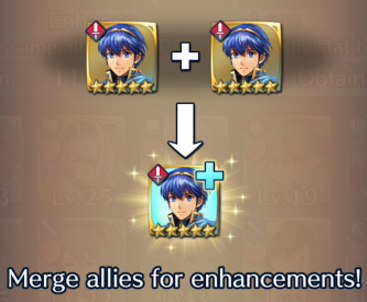
So to have the highest level 5 star Marth (pictured above), you need two 5 star Marths. This is a very small chance in the Gacha (0.001% per summon), and will obviously take a long long time to do.
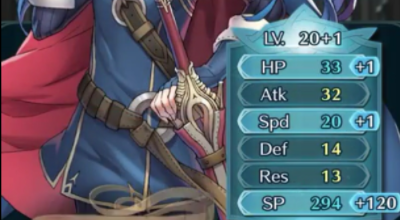
However, this gives only +1 level on the character. As pictured above, the character now can have a maximum level of 40+1, rather than 40. This means that the benefit of spending all the time effort in the gacha to get the duplicate is all for a maximum of +1 to +5 battle stat points. The single level boost is just too low for too much grind.
Compare this to Galaxy of Heroes, Summoner’s War and Heroes Charge. Their upgrade systems have more systems running in parallel and typically have far more requirements to reach the optimal build:
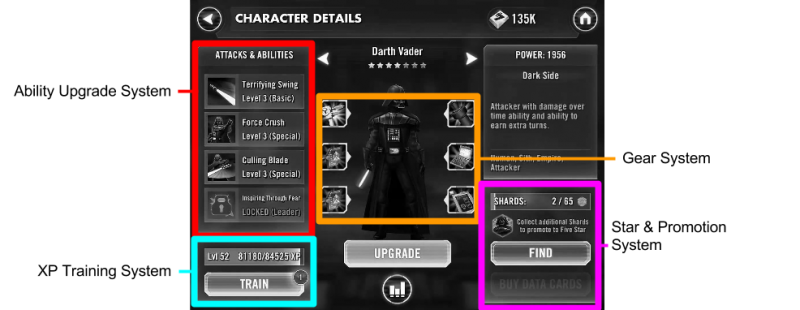
Outlined far more in detail in an older deconstruction, most F2P RPG games have 4 paths to upgrade your character to the maximum. Usually including a random drop gear system at least to make the long path to fully upgrade interesting throughout the development.
The key element that Fire Emblem is missing: If I’m lucky enough to land a 5 star character, this needs to feel like just the beginning. I shouldwant to invest a lot of time to get this hero to their maximum potential.
This is how you ultimately craft strong long term retention in a game which drives long term success on the mobile top grossing charts.
#3 Lack of Content Social End-Game
Free-to-play, at its foundation, is about retaining players for as long as possible. Long term retention decides your ultimate success, as I’ve spoken about at GDC, and written on this blog.
But just a week after launch, and there are many reports of players reaching the end of content. Many of these players have been moderately engaged and only spent a small amount of money. Below the player spent $40, only on summoning, and reportedly did not even get their final hero team from any of the summons they paid for.
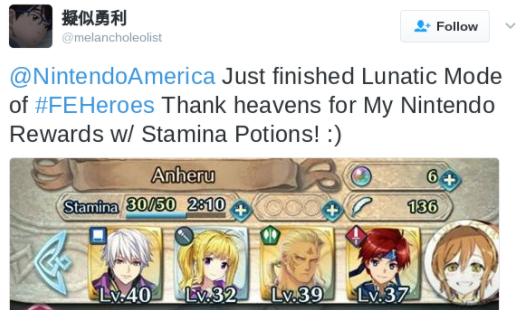
This is a result of generous gacha drops and quick upgrade pathing. Players being able to upgrade and progress through all the content much faster than Nintendo intended.
If Nintendo wants Fire Emblem to continue to deliver million dollar per day revenues for months and years to come, they need to ensure their most engaged players are staying in the game. They can only do that if there is enough content in the game.
The easiest way for a game to lose its audience is for its most engaged players to leave because they feel like they finished all the game had to offer.
Fire Emblem has 9 Chapters + a Prologue containing just under 150 missions. With the pace that fire emblem lets you get through these missions though, these 150 missions, each lasting between 40 seconds and 3 minutes makes for a very fast progressing game.
The side-effects of this fast progression is that Nintendo needed to add very aggressive pacing blocks to their single player campaign. The majority of complaints from players have to do with the stamina cost of levels skyrocketing early. By the mid-game, each battle costs roughly 10 stamina, and your stamina meter remains at 50. With battles being so short and most battles being fairly trivial to win (since you’re grinding), this feels frustrating by the end game. Nintendo had to do this to prevent players from training beating the campaign missions too early. If they had created enough content however, this wouldn’t be the case. If they added additional modes to the end-game to pressure players into collecting upgrading more heroes, this wouldn’t be the case.
Comparar esto con Galaxy of Heroes, Contest of Champions, Summoner's War y Brave Frontier es completamente diferente. Cada uno de estos juegos ofrece más modos, más contenido y su ritmo se estructura en torno al juego en lugar de esperar. Además de esto, estos juegos introducen lentamente un final social cada vez más atractivo que elimina la presión de producir más contenido. De esta manera, incluso si un jugador muy comprometido y con grandes gastos llega al final del contenido antes de tiempo, participará activamente en guerras de gremios o alcanzará la cima de una tabla de clasificación.
Los héroes de Fire Emblem tienen las herramientas para hacer esto. Con el éxito de Fire Emblem Heroes, planean lanzar 2 capítulos (10 niveles) cada mes . Planean introducir un nuevo modo PvP en un futuro próximo. Tienen un modo arena, pero su ritmo es demasiado lento (3 intentos máximo por día). Pueden crear un metajuego basado en gremios que impulse a los jugadores a usar sus listas de amigos. Agregar más modos adicionales que le pidan al jugador que tenga una colección más grande de héroes para subir de nivel sería la clave para impulsar una mayor retención a largo plazo.
Tal como están las cosas, los jugadores pueden avanzar en el contenido demasiado rápido, lo que los deja con muy pocas razones para volver al juego.
Cómo puede durar Fire Emblem
En general, este juego es un gran éxito financiero para Nintendo. Basado en la base de fanáticos rabiosos hasta ahora, Nintendo ha demostrado que basándose únicamente en la lealtad a la marca, su base de fanáticos puede alcanzar la cima de las listas de juegos móviles. Tienen una batalla central impresionantemente accesible y adictiva que tiene la profundidad estratégica para durar años.
Dicho esto, Nintendo tiene aquí una oportunidad no sólo de ganar dinero rápido con su propiedad intelectual. Tienen la oportunidad de construir un éxito duradero que superará a Super Mario Run en ingresos, e incluso potencialmente a Pokémon Go en el futuro.
Para que este juego se mantenga en la cima, Nintendo debe actuar rápidamente para garantizar que pueda retener a sus mejores jugadores.
- Agregue más niveles de estrellas a su grupo de Gacha, para que haya una razón para que los jugadores invoquen nuevos personajes durante años.
- Agregue más escala y profundidad a su sistema de actualización, para que mis personajes principales tarden más de una semana en alcanzar sus formas óptimas.
- Añade mucho más contenido para desafiar a los jugadores a reunir más héroes y mejorar su equipo al más alto nivel.
- Trabaja para lograr un final social más profundo que mantenga a los jugadores colaborando y jugando durante años.
Estas 4 cosas son posibles en poco tiempo. Mientras el público sigue participando en el juego, Nintendo puede aumentar la escala de los sistemas y añadir contenido importante. Galaxy of Heroes y otros tardaron meses después del lanzamiento global antes de lanzar un final social. Puzzles and Dragons agregó niveles de estrellas mucho después del lanzamiento. Muchos de los JRPG del género tienen modos y competiciones interesantes que empujan a los jugadores a reunir y mejorar un gran conjunto de héroes.
Nintendo tiene el tiempo y la capacidad para convertir Fire Emblem de un lanzamiento de un millón de dólares a un éxito móvil de mil millones de dólares.
Leave a Reply